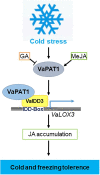GRAS-domain transcription factor PAT1 regulates jasmonic acid biosynthesis in grape cold stress response
- PMID: 33752238
- PMCID: PMC8260143
- DOI: 10.1093/plphys/kiab142
GRAS-domain transcription factor PAT1 regulates jasmonic acid biosynthesis in grape cold stress response
Abstract
Cultivated grapevine (Vitis) is a highly valued horticultural crop, and cold stress affects its growth and productivity. Wild Amur grape (Vitis amurensis) PAT1 (Phytochrome A signal transduction 1, VaPAT1) is induced by low temperature, and ectopic expression of VaPAT1 enhances cold tolerance in Arabidopsis (Arabidopsis thaliana). However, little is known about the molecular mechanism of VaPAT1 during the cold stress response in grapevine. Here, we confirmed the overexpression of VaPAT1 in transformed grape calli enhanced cold tolerance. Yeast two-hybrid and bimolecular fluorescence complementation assays highlighted an interaction between VaPAT1 with INDETERMINATE-DOMAIN 3 (VaIDD3). A role of VaIDD3 in cold tolerance was also indicated. Transcriptome analysis revealed VaPAT1 and VaIDD3 overexpression and cold treatment coordinately modulate the expression of stress-related genes including lipoxygenase 3 (LOX3), a gene encoding a key jasmonate biosynthesis enzyme. Co-expression network analysis indicated LOX3 might be a downstream target of VaPAT1. Both electrophoretic mobility shift and dual luciferase reporter assays showed the VaPAT1-IDD3 complex binds to the IDD-box (AGACAAA) in the VaLOX3 promoter to activate its expression. Overexpression of both VaPAT1 and VaIDD3 increased the transcription of VaLOX3 and JA levels in transgenic grape calli. Conversely, VaPAT1-SRDX (dominant repression) and CRISPR/Cas9-mediated mutagenesis of PAT1-ED causing the loss of the C-terminus in grape calli dramatically prohibited the accumulation of VaLOX3 and JA levels during cold treatment. Together, these findings point to a pivotal role of VaPAT1 in the cold stress response in grape by regulating JA biosynthesis.
© American Society of Plant Biologists 2021. All rights reserved. For permissions, please email: journals.permissions@oup.com.
Figures








Similar articles
-
Overexpression of VaPAT1, a GRAS transcription factor from Vitis amurensis, confers abiotic stress tolerance in Arabidopsis.Plant Cell Rep. 2016 Mar;35(3):655-66. doi: 10.1007/s00299-015-1910-x. Epub 2015 Dec 19. Plant Cell Rep. 2016. PMID: 26687967
-
Bundling up: VaPAT1 forms a complex with VaIDD3 to activate cold tolerance in Amur grape calli.Plant Physiol. 2021 Jul 6;186(3):1373-1374. doi: 10.1093/plphys/kiab203. Plant Physiol. 2021. PMID: 34624111 Free PMC article. No abstract available.
-
The transcription factor VaNAC17 from grapevine (Vitis amurensis) enhances drought tolerance by modulating jasmonic acid biosynthesis in transgenic Arabidopsis.Plant Cell Rep. 2020 May;39(5):621-634. doi: 10.1007/s00299-020-02519-x. Epub 2020 Feb 27. Plant Cell Rep. 2020. PMID: 32107612
-
Jasmonate regulates leaf senescence and tolerance to cold stress: crosstalk with other phytohormones.J Exp Bot. 2017 Mar 1;68(6):1361-1369. doi: 10.1093/jxb/erx004. J Exp Bot. 2017. PMID: 28201612 Review.
-
An integrative overview of cold response and regulatory pathways in horticultural crops.J Integr Plant Biol. 2025 Apr;67(4):1028-1059. doi: 10.1111/jipb.13903. Epub 2025 Apr 11. J Integr Plant Biol. 2025. PMID: 40213955 Review.
Cited by
-
Gene Editing for Plant Resistance to Abiotic Factors: A Systematic Review.Plants (Basel). 2023 Jan 9;12(2):305. doi: 10.3390/plants12020305. Plants (Basel). 2023. PMID: 36679018 Free PMC article. Review.
-
VaWRKY65 contributes to cold tolerance through dual regulation of soluble sugar accumulation and reactive oxygen species scavenging in Vitis amurensis.Hortic Res. 2025 Jan 3;12(4):uhae367. doi: 10.1093/hr/uhae367. eCollection 2025 Apr. Hortic Res. 2025. PMID: 40078721 Free PMC article.
-
Genome-wide identification and expression pattern analysis of NAC family in Taxus yunnanensis and the TyuNAC30 role in paclitaxel production.BMC Genomics. 2025 Jul 31;26(1):705. doi: 10.1186/s12864-025-11916-z. BMC Genomics. 2025. PMID: 40745264 Free PMC article.
-
Genome-wide identification and expression analysis of the GRAS transcription in eggplant (Solanum melongena L.).Front Genet. 2022 Sep 2;13:932731. doi: 10.3389/fgene.2022.932731. eCollection 2022. Front Genet. 2022. PMID: 36118872 Free PMC article.
-
Jasmonate enhances cold acclimation in jojoba by promoting flavonol synthesis.Hortic Res. 2024 May 3;11(7):uhae125. doi: 10.1093/hr/uhae125. eCollection 2024 Jul. Hortic Res. 2024. PMID: 38966867 Free PMC article.
References
-
- Ba L, Jianfei K, Chen J, Lu W (2016) MaJAZ1 attenuates the MaLBD5-mediated transcriptional activation of jasmonate biosynthesis gene MaAOC2 in regulating cold tolerance of banana fruit. J Agric Food Chem 64:738–745 - PubMed
-
- Bolle C (2004) The role of GRAS proteins in plant signal transduction and development. Planta 218:683–692 - PubMed
-
- Böttcher C, Burbidge CA, di Rienzo V, Boss PK, Davies C (2015) Jasmonic acid-isoleucine formation in grapevine (Vitis vinifera L.) by two enzymes with distinct transcription profiles. J Integr Plant Biol 57:618–627 - PubMed
Publication types
MeSH terms
Substances
LinkOut - more resources
Full Text Sources
Other Literature Sources

